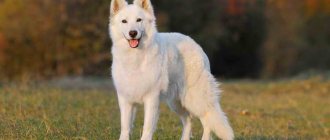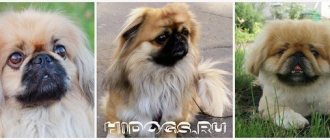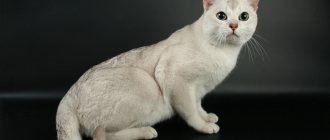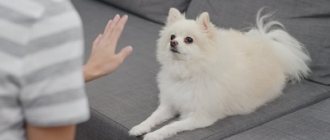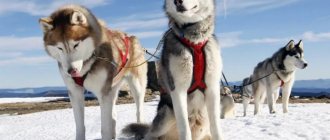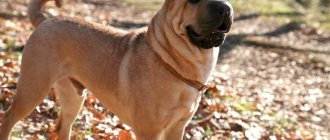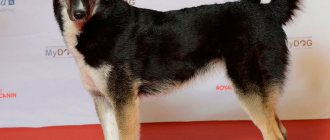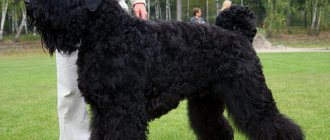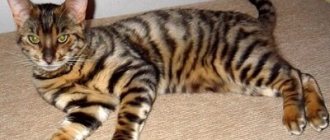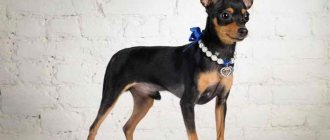/ Dogs / Dog breeds / Description of the Chesapeake Bay Retriever breed
0
1530
Article rating
Today, retrievers are best known throughout the world as family dogs, distinguished by their playfulness, affection and intelligence. However, among the six representatives of the breed, the Chesapeake Bay Retriever is the most valuable for hunters. This dog is an excellent duck hunting companion, and there are a number of factors in its favor that require more detailed consideration.
Chesapeake Bay Retriever
Description and features
The Chesapeake Bay Retriever breed is quite large. The height of males reaches 58-66 cm with a weight of 31-36.5 kg, females - 54-62 cm with a weight of 26-32 kg. But appearance is created not by size, but by complexion. The Chesapeake, or Chessie for short, has a look of strength and endurance.
Perhaps this impression is made by a muscular neck, a voluminous chest and stable, even legs. In general, the dog looks powerful, but very harmonious. The main feature of these dogs is their purpose. They were bred to work on waterfowl in all weather conditions. And they are very good at this.
Tireless workers are able to swim for a long time in icy water, breaking the ice crust, and moving against the current and wind. And with age, these qualities do not disappear; the dog remains a worker, strong and efficient until the end of his life. Moreover, he can be called a professional with a capital P.
The Chesapeake Bay has excellent instincts and will find game in impassable areas.
Because, in the absence of hunting, he is fully trainable for guard and security service, the work of a guide, rescuer or nurse. Although American breeders, trying to maintain the status of a gun dog, do not encourage its use simply as a pet.
The Chesapeake Bay Retriever in the photo looks like a sculpted plush sculpture, especially when he assumes a stationary stance.
Only his attentive and soulful eyes reveal him as a lively, devoted and very intelligent dog.
Description of character
The character of the pets is very cheerful and kind, but at the same time they are very smart, careful and courageous. These qualities make them good guards. However, dogs of this breed can be willful, so they need strict education and good training.
You cannot allow him to perform some action supposedly just once, otherwise it will be very difficult for you to retrain him later. To prohibit, you must use a stern voice and an equally stern look. This is enough for dogs of this breed; a more serious punishment is unnecessary and the pet, filled with resentment, may begin to behave even worse.
Training the Chesapeake usually goes without complications. They are very intelligent and obedient, willing to please their owner by following his commands, although their training can be called slow compared to other breeds. Water is the element of these dogs; they love to swim.
These retrievers get along well with children. They can also get along with cats living in the same house with them.
NOTE! Other cats on the street will attract their attention and they will still run after them.
It is not recommended for an inexperienced dog breeder to own a Chesapeake Bay Retriever. The owner of such a dog must have a strong character in order to show his pet his power. Chesapeakes will try to lead in relationships and the owner will always have to prove his power to the dog. It is better to take an obedience training course with this dog.
IMPORTANT! If the dog feels shy or passive in its owner, problems may arise with its upbringing.
When raising Chesapeakes, much attention should be paid to their socialization. They should be introduced to other dogs from a very early age.
Breed standards and character
General appearance: muscular dog, with a rectangular body format, a wide skull and a moderately pronounced stop. The jaws are strong and large enough to carry prey without damaging it. The coat is short and coarse, with a dense undercoat. Can be a little wavy, but not on the paws.
It is impregnated with a specific composition of fat that protects the dog from hypothermia in icy water. The quality of the wool is very important when choosing, as it affects the efficiency of work. When leaving the water, the dog shakes himself off, and after this the fur should remain dry, like a goose feather.
Chesapeake Bay Retriever is a powerful, muscular dog.
Color is allowed in any brown tones - from the color of reeds to the shade of dried leaves. Plain color is most preferable. Although it is acceptable to have several white spots no larger than the size of the paw pads - on the chest, belly and bottom of the paws. Interestingly, when assessing appearance, noble scars do not affect the score.
The back is short and straight, the tail is also straight, only a slight curve is allowed, but not towards the body. All limbs are moderately high, straight, with strong muscles; in puppies the fifth and dewclaws are removed. The muzzle has the shape of a cone, pointed towards the nose. Scissor or straight bite.
The ears are thin, long, set tightly, hanging freely on the sides of the head. The movements are smooth, free, light, and you can feel the strength in them. When viewed from the front, the elbows and hocks should not stick out in different directions.
Eyes are a special element in the description of this dog. Their cut, as well as their amber color, make the dog look very intelligent, with an attentive look, and an interested and friendly expression.
According to the standard, the animal’s temperament must be “bright and happy.” Probably, the manufacturers put into this concept a cheerful, even character, courage, intelligence, flair, and willingness to work. They are characterized by tolerance towards all family members, especially children, and selfless devotion to the owner.
This dog breed needs long walks and swimming every day.
He always strives to curry favor with the person most important to him. They will not ignore a stranger’s aggression, although they themselves will not attack first. Animals with hydrophobia, malocclusion, excessively curly hair, black color and white spots, sizes and in places not provided for by the standard are disqualified.
Chesapeake Bay Retriever. Owner's impressions.
Pyotr Zhukovsky, owner of CAROWAY'S CHESS QUEEN OF RUSSIA (2005) tells
So, a year has passed since I welcomed a Chesapeake Bay Retriever puppy into my home. I want to share some of my impressions.
Over this year, Chess has grown from a small touching puppy into a very powerful, strong and agile dog. She has caught up in height with my five-year-old golden Bianca, who is a fairly large dog for her breed, and in games is not inferior to her in strength, and surpasses her in speed and agility. Chess and I live outside the city, next to a huge pond, a forest and a large field. So we have plenty of places where you can run, swim and exercise. Chess and Bianca spend most of their time outdoors in a spacious enclosure under a roof, where, however, there are cozy booths in which even a storm is not scary.
Chess's color is the color of withered grass, which makes her almost invisible in the field and forest. Eyes the color of whiskey, black pupils make the look animalistic and cold. The coat is thick and coarse and curls on the back. Chess does not have any specific smell that is persistently attributed to the Chesapeake.
CAROWAY'S CHESS QUEEN OF RUSSIA
Little Chess with her friend Golden Bianca
From early childhood, Chess showed a desire to take a leading position in our “pack”. And it took a lot of patience and a lot of obedience training before she recognized me as the “leader.” In addition, a lot of attention was paid to socialization.
Of course, my most important impression of the Chesapeake is that it is not a dog for everyone: the desire for leadership, hyperactive nature, the need for daily training (the dog learns more slowly than, for example, Goldens or Labradors) and long walks require a lot of time and effort. Otherwise, you risk getting an uncontrollable, strong beast that will only bring you inconvenience and will suffer. However, if you provide the Chesapeake with the right regime, the necessary education and proper training, all this will be more than compensated for and you will get an excellent hunting dog. In my opinion, you should only take a Chesapeake if you are going to actively use it for hunting and have the opportunity to keep it outside the city.
In relation to unfamiliar dogs, Chess shows neither aggressiveness nor desire to play. She only plays with pleasure with her well-known goldens Bianca and Manya (Bianca’s daughter, who often comes to visit). My Chesapeake is indifferent to strangers, but if he comes across someone he knows, he is very happy and starts to lick him.
As a hunter, Chess impresses everyone with his passion for achieving his goals. This is truly a terminator retriever. There are no obstacles for him on the way to the duck. Once, in order to quickly overcome an impassable windbreak on the way to the lake where she was sent to get a duck, Chess instantly made a decision and jumped onto the lower branches of a tree and crawled along them over the windbreak! And her desire to grab the fleeing duck at any cost more than once forced her to dive under the water, while the dog was completely hidden under water. True, this passion also has its downside - the dog is doomed to injury. Chess has severely cut her paws twice this season.
Starting in May, we devoted all our free time to training. Result - Chess Russian Champion in working qualities, Field Champion in duck, Field Champion in blood trail. The hunting season is ahead, the real hunt.
We do not attend exhibitions yet. For the first and only time, Chess was exhibited at the RRK spring show, where she received an excellent rating. Our plans this year are to take part in two more exhibitions: the exhibition in Nizhny Novgorod and the autumn exhibition of the RRK (2005).
About the working qualities of the Chesapeake
I'm happy to have such a dog. We devote all our free time to training and Chess does an excellent job. When she sees a duck, for her, except for me and her, everything else ceases to exist. Last weekend at training she worked with labradors and twice amazed everyone with her will to win: - the first time on the way to the duck there was an impassable windfall in front of her, which all the dogs avoided - so she just looked up, jumped onto a tree and along the branches, across She crawled forward along them and jumped straight into the water from a tree. Moreover, all this happened quickly, she made the decision instantly; - another time, chasing a duck that ran away from her and dived, she twice dived under the water after it, completely disappearing under water. Moreover, this happened non-stop: the duck swims quickly, Chess catches up with it, the duck dives right in front of its mouth and Chess instantly dives after it. She didn't grab it underwater, but the sight was amazing!
History of the breed
The Chesapeake Bay is essentially part of the Atlantic Ocean. Its unique appearance was the result of the formation of a crater, which was a kind of dam for the Susquehanna River. Due to the many rivers and rivulets (more than 150 large and about 100 thousand small) flowing into this estuary, the water there is cold, if not icy.
In such conditions, it was not easy for hunters to get shot game from the reservoir. At the beginning of the 19th century, an English sailing ship crashed off the coast of the continent, but the crew escaped and left two dogs from Newfoundland with the local population. They helped the natives pull wounded ducks out of the frozen water.
The Chesapeake Bay Retriever is an indispensable assistant for duck hunting.
The unique feature of being in the cold for a long time was noticed by hunting enthusiast and dog breeder Dr. James Stewart. He crossed a chestnut male from a pair of castaways with dark fawn Coonhound females.
Then, various breeders began to add Irish water spaniels, retrievers, and setters to the breed. It was finally formed in the second half of the 19th century, and instantly gained popularity among hunters for its courage, courage and endurance in difficult conditions.
The dog was registered in 1878 by the American Kennel Club. And the Chesapeake Club was legalized in 1918, and became the first retriever club in the United States. Today, up to 1,000 puppies are registered in their homeland per year. In terms of popularity there, the breed is second only to Labradors and golden retrievers.
Care and maintenance
The Chesapeake Bay Retriever dog is very active and needs long walks every day. Otherwise, your personal belongings and pieces of furniture will suffer, and the dog, out of boredom, can make a real mess in the room. The best option is morning and evening departures for an hour.
Moreover, these should not be leisurely exercises; jogging, games, and trips to reservoirs are welcome. The dog loves to bathe and swim. Training a puppy is difficult, but it is better to do it yourself under the supervision of a professional. Otherwise, it will be difficult for the animal to decide who the real owner is.
The dog must have trust and respect for you, otherwise he will not listen. With patience and creativity, parenting can be fun for both of you. However, it must be taken into account that the character of the animal contains a share of stubbornness, therefore, at the slightest disobedience, it is necessary to make it clear that he is wrong.
There are no special problems in terms of coat care; it is enough to brush it daily with a stiff brush. But if you have such a pet at home, you should know in advance that they can emit an odor. And it is impossible to fight this, such are the properties of their unique waterproof fur. However, bathing with shampoo is often not recommended; three times a year is enough.
In addition, this is a labor-intensive procedure, since the wool gets wet very poorly. It is enough for a loving owner to devote a few minutes a day to examine the pet. Carefully examine the body for scratches, bald spots, and parasites. Next, check your eyes for redness or mucus. Feel free to not only look, but also smell the ears.
They should not have an unpleasant odor. Teeth are an important part of the examination. They must be snow-white. In addition to being clean, they can crack and split. It is necessary to clean the stone. The claws need to be trimmed once every 2-3 weeks, although most often the dog grinds them off on his own.
These powerful and intelligent dogs make excellent guards.
Nutrition
Chesapeakes are not capricious in their choice of food, but the amount of protein and calcium in foods is of great importance for their diet. Already in childhood, it is worth deciding on the type of food to choose - natural, factory-made or mixed.
In the first case, the portion is calculated based on physical activity; overeating is extremely undesirable. From an early age, select the correct amount; if the puppy does not finish eating, reduce the dose. The Chessie has an excellent appetite, so he can quickly gain weight, and this leads to illness.
The second option is the most optimal, since it does not require additional vitamin supplements; high-quality factory feed is already balanced. The third option, like the first, should be supplemented with vitamins and minerals.
An important rule for natural feeding is no handouts from the table, scraps, sweet, spicy, or fatty pieces. Nutrition should be complete and healthy. Broth-based porridge, lean meat, vegetables and fruits, dairy products, herbs and always clean water.
Reproduction and lifespan
On the territory of the Russian Federation and the former countries of the Soviet Union, the Autumn breed is rare. There are no professional breeders here. Puppies should only be brought from abroad. There is no point in breeding it yourself - the trouble will not be worth it.
You should buy a baby only from nurseries with licensed activities, a good reputation and many years of breeding experience. You may find private breeders on the Internet whose prices will be lower, but in this case there is a high risk of getting a dog with hidden defects or not a pure breed.
Chesapeake Bay Retriever puppies should be able to fetch a toy or ball from childhood. When choosing a dog, pay attention to the appearance of the parents - your pet will look like them. If in doubt, look for another option. When purchasing, ask for all documents, including a veterinary passport with vaccination marks.
Observe the baby’s behavior; he should be playful, active, and not fearful. Check your hearing and vision - drop your keys nearby and wave your hand in front of him. Before you take home the little one you like, consult with a professional. Chesapeakes live for about 10 years. The most typical diseases are joint dysplasia, retinal atrophy, and skin diseases.
Who is it suitable for?
The character of the independent Chesapeake Bay Retriever is characterized by independence. The dog simply needs it when searching for game, because no one will tell it how to find downed prey. To properly raise a Chessie, you need a strong hand and unquestioned authority. Therefore, the owner of the breed should be an experienced dog lover, preferably a hunter. The indecision of novice dog breeders can spoil the character of the animal, which will be expressed in the desire to dominate and aggression when prohibited from doing what is desired instead of what is required.
Retriever puppies need to be socialized as early as possible: introduced to a large number of other dogs, other animals and people, and taken with them to visit places other than their permanent home conditions.
The wool lubricant inherent in the breed has a specific odor. Considering this factor and its considerable size, the best living conditions for a dog are a country house with a courtyard. Here it is easier to realize the potential of an animal that needs more space for active games and jogging. A Chesapeake Bay Retriever can do a lot of damage to an apartment without having an outlet for its energy. This breed is unlikely to be suitable for a passive owner who does not give the retriever proper exercise.
Chessie is recommended for families with older children, with whom the breed gets along well. However, contact between young children and the retriever must be supervised.
The character of a retriever, if it is properly raised, is friendly, accommodating, playful, persistent when searching for game. If other dogs hunt for the owner, then the Chessie has this property of nature: be sure to find and bring. At the same time, an intelligent animal does not finish off the game and does not eat it.
